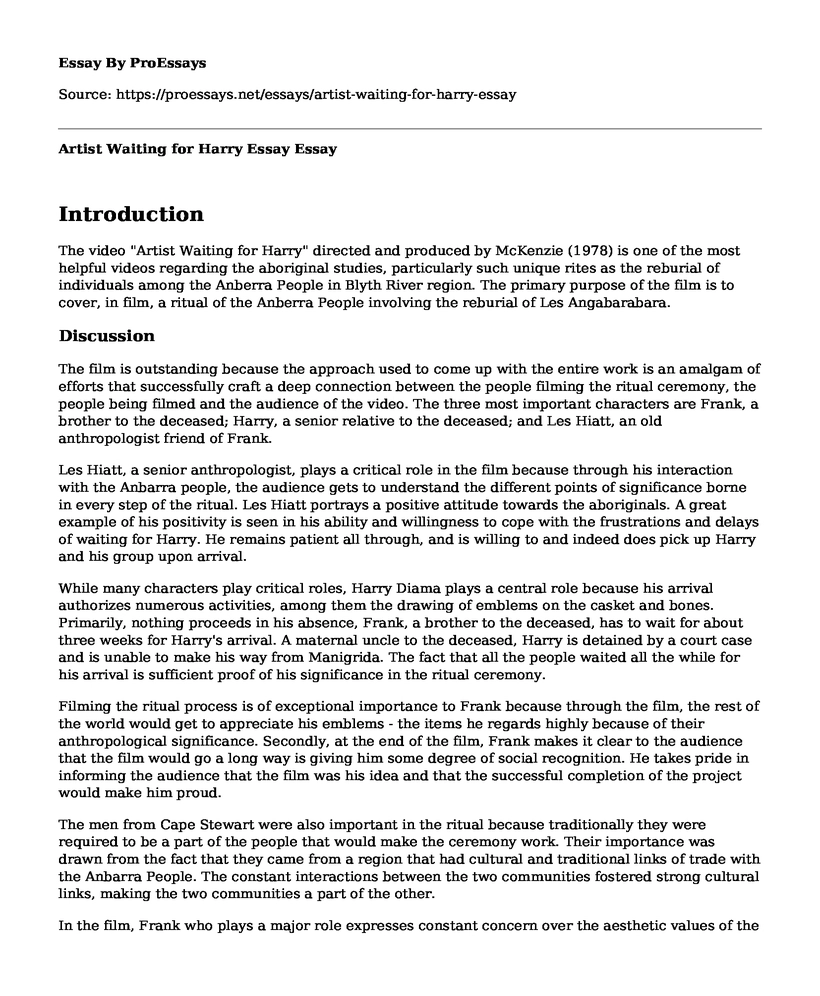Introduction
The video "Artist Waiting for Harry" directed and produced by McKenzie (1978) is one of the most helpful videos regarding the aboriginal studies, particularly such unique rites as the reburial of individuals among the Anberra People in Blyth River region. The primary purpose of the film is to cover, in film, a ritual of the Anberra People involving the reburial of Les Angabarabara.
Discussion
The film is outstanding because the approach used to come up with the entire work is an amalgam of efforts that successfully craft a deep connection between the people filming the ritual ceremony, the people being filmed and the audience of the video. The three most important characters are Frank, a brother to the deceased; Harry, a senior relative to the deceased; and Les Hiatt, an old anthropologist friend of Frank.
Les Hiatt, a senior anthropologist, plays a critical role in the film because through his interaction with the Anbarra people, the audience gets to understand the different points of significance borne in every step of the ritual. Les Hiatt portrays a positive attitude towards the aboriginals. A great example of his positivity is seen in his ability and willingness to cope with the frustrations and delays of waiting for Harry. He remains patient all through, and is willing to and indeed does pick up Harry and his group upon arrival.
While many characters play critical roles, Harry Diama plays a central role because his arrival authorizes numerous activities, among them the drawing of emblems on the casket and bones. Primarily, nothing proceeds in his absence, Frank, a brother to the deceased, has to wait for about three weeks for Harry's arrival. A maternal uncle to the deceased, Harry is detained by a court case and is unable to make his way from Manigrida. The fact that all the people waited all the while for his arrival is sufficient proof of his significance in the ritual ceremony.
Filming the ritual process is of exceptional importance to Frank because through the film, the rest of the world would get to appreciate his emblems - the items he regards highly because of their anthropological significance. Secondly, at the end of the film, Frank makes it clear to the audience that the film would go a long way is giving him some degree of social recognition. He takes pride in informing the audience that the film was his idea and that the successful completion of the project would make him proud.
The men from Cape Stewart were also important in the ritual because traditionally they were required to be a part of the people that would make the ceremony work. Their importance was drawn from the fact that they came from a region that had cultural and traditional links of trade with the Anbarra People. The constant interactions between the two communities fostered strong cultural links, making the two communities a part of the other.
In the film, Frank who plays a major role expresses constant concern over the aesthetic values of the Casket. He insists that it must look presentable for filming. The casket is a hollow log - a huge piece of a tree stem conveniently carved out to act as a coffin. The casket is decorated with cultural emblems that represent different culturally significant symbols. Another part of the ritual that is worth noting is the making of the sand sculptures.
Conclusion
In conclusion, the film elaborately covers all the aspects of the above discussion in a detailed fashion. The cultural symbols used in the film are worth noting, particularly because they are among the factors that motivate Frank to conceive the idea of making the film. The sand sculptures are considered an important aspect of the ceremony as they are a part of the items that symbolically explain the lives of the Anbarra people from the anthropological lens. Additionally, the traditional dances that characterized the ceremony are also a part of the rituals of the reburial ceremony.
Works Cited
McKenzie, Kim. "Waiting for Harry." (1980).
Cite this page
Artist Waiting for Harry Essay. (2022, May 15). Retrieved from https://proessays.net/essays/artist-waiting-for-harry-essay
If you are the original author of this essay and no longer wish to have it published on the ProEssays website, please click below to request its removal:
- Japanese Theater (Kabuki) Essay
- Hidden Figures, the Silence in Audacity Essay
- Reaction to Reading About Nonverbal Communication
- Symbolism in Shirley Jackson's Story 'The Lottery' Essay
- Symbolism in Theatre and Cinema
- Satire in Movies: Criticizing Human Faults for Moral Judgment - Essay Sample
- Paper Sample on Elderly Couple Reunites with Daughter & Fiance at Golden Pond







